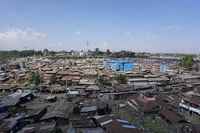Extra Judicial Killings in Nairobi and Community Based Response
Nairobi has been faced with systemic police violence throughout its colonial and post-colonial history. This article was written after Insitut Français de Recherche en Afrique (IFRA) Center for Human Rights and Policy Studies (CHRIPS) and Mathare Social Justice Center (MSJC) hosted a seminar on the topic. The article focuses on the case of Nairobi and demonstrates how urban planning and police violence go hand in hand. It then continues to discuss how communities have reacted and their methods used to try and alter the way police operate in their communities.
Introduction and context
On the 23rd and 24th of January, the Insitut Français de Recherche en Afrique (IFRA), Center for Human Rights and Policy Studies (CHRIPS) and Mathare Social Justice Center (MSJC) hosted a conference on police violence, state transformations and mobilization with comparative perspectives from Kenya and France. In recent years, movements across the globe have rendered public state led violence against marginalized communities. When it comes to police violence, marginalized communities entail: people of different “ethnic” or “racial” background, people of lower socio-economic status, certain age and gender groups: usually young men in their 20s. This article will focus on outlining the structural issues surrounding police violence, and community based resistance. Equally, the article will demonstrate how police violence is not something that can be viewed as an isolated phenomenon. It is intrinsically linked to how the city is planned and authority is exercised. The communities facing the full force of this violence are usually placed outside the city centers and segregated residential areas with little access to amenities and services relative to their other urban neighbors. Lastly, these segregated communities in both “global north and south”, inherit from colonial planning which has been largely reinforced through the post-colonial era.
Despite the perceived differences between Kenya and France, the aim of the conference was to create a platform for shared experiences, comparative institutional analysis and an exchange of tactics, possibilities and forms of mobilization in both countries. The speakers at the conference emanated mainly from academic, NGO and activist backgrounds. The first day was primarily dedicated to the institution of the police and how it engages with its citizens in both countries. It soon became very transparent that there is a large difference in volume of police killings in-between France and Kenya. The inhabitants and activists of Mathare, an informal settlement area on the east of Nairobi, claim that a young man gets killed almost every week. Another estimate is that between 2013-2015 there have been 150 shot dead by police in the area (Van Stapele, 302). Furthermore, many young men of Mathare and other communities fear returning home at night, therefore limiting their movements throughout the city. Similarly, the choice of wearing certain hairstyles such as dreadlocks places them under greater danger. In France, according to Jérémy Gauthier, it is estimated that around 15 people die at the hands of police every year. In France, many killings take place in poorer areas of the city such as: Seine-Saint-Denis or Val-d’Oise.
Planning and spatial distribution of power
Poorer areas have been and still are spaces of “concern” for both the government and the upper classes of any given country, a notion often repeated at the conference. As a result policing and exercising authority is considered to be of prime importance to the maintenance of social order. In his article titled “Urban planning as a tool of power and social control in colonial Africa”, Ambe Njoh describes how cities in Africa were built to maintain a physical form of domination and power relations. The colonial powers placed institutions of monitoring on high-grounds overlooking the urban poor. In addition, they made sure there were large distances between the “city or la ville” and the native settlements. The overall impact of structures and public space was made to ensure that there was a feeling of colonial institutional omnipresence, a phenomenon that was also replicated in the colonizer’s country (Njoh 2009). Replicating Njoh’s comments in current urban politics in Nairobi, we see that these structures have not changed. If we take Mathare, one finds police stations at the entrance to the community, a way to monitor the coming and going of the informal settlement areas. Secondly, opposite Mathare one finds the Moi Forces Academy and the Moi airbase, two military establishments. Just to the west of Mathare there is also the Mathare mental hospital. Not to disregard the benefit that this hospital can bring to the community, but in Foucauldian terms it also serves as an establishment of social control. Mathare is built in a valley, once a quarry for Nairobi. The morphology of the settlement has allowed for two main boulevards to enclose the settlement, one is Juja road. On the other side of valley lies Thicka road, another large boulevard. More importantly, behind Thicka road lies Muthaiga, a rich community where one finds 4 walled villas and ambassador’s residences. Simply listing the structures and physical barriers that lie around Mathare demonstrate how marginalized communities have been designed to facilitate state control. In turn, the constant police violence that incessantly attacks communities across Nairobi is the muscular arms of the state body, an extension of the control exercised through planning. Such urban layout reflects the message repeated on day 1 on the conference, that the police does not perform police work, rather it is a force of social control.
Community based initiatives
In the face of perpetual systemic violence, communities such as Mathare put in place tools in order to reclaim discourse and space (space-making). As Naomi van Stapele explains, young men in “ghettos” turn their allegiance to their communities first and foremost, to the point where they distance themselves from the rest of the city or tao as they call it (315). They see themselves as defenders from the encroaching state, a feeling which reverberated throughout the two day conference. In Mathare, a group has formed called the Mathare Social Justice Center (MSJC- co-organizers of the two day event). Since 2015, this group has been actively documenting police killings in their neighborhood. Such an initiative has been unprecedented in Nairobi, due to the extreme risk the group members put themselves. Their work has culminated in a booklet titled “Who is Next? : A Participatory Action Research Report Against the Normalization of Extrajudicial Executions in Mathare.” This book informs the reader about the situation in Mathare whilst also listing 50 cases of deaths at the hands of the police. Such initiatives have made waves in surrounding communities, leading to similar proposals in communities such as Dandora. These tools provide communities a way to defend themselves legally. Yet they also enable victims of state led violence to reclaim the narrative on how they are not the criminals and the threats to urban life the establishment relegates them to.
Other initiatives of the MJSC are the Mathare Green Movement (MGM). The MGM clears up spaces in order to plant trees across the settlement. It tackles 4 main issues: the lack of green space, ability to provide fresh fruit from the trees, the grassroot led beautification of the area and a form of memorialization of the victims of police executions. Besides the MGM, the community also runs musical programs and writing initiatives such as Heroes of Mathare where they promote a “different” side of their settlement. Their work has had successes largely through the help of social media platforms, with Skeme music (a group from Mathare) making waves on Youtube.
The delicate nature of change and space claiming
The fight to reclaim and recreate space, also known as space making, is in a constant tussle between “formal” and the “informal” or “insurgent” actors. It is not just Mathare that faces this battle, but other marginalized spaces in Nairobi or in Paris. There are those that are the structuring agents, but invisible to their eyes is the local street level actor which through his or her practices of everyday life reshapes the spaces he lives in (De Certeau). Far too long have these grassroot movements and urban poor been considered actors outside the realm of planning, it is time that planning becomes considered as a contest field with multiple actors (Roy, 10). It is important to note that these actors have influence beyond planning, their actions also have impact on other forms of injustices such as police violence. Nonetheless, it’s easy to provide such prescriptive statements; in real life, communities face a difficult balancing act when it comes to dealing with powerful agents. As repeated throughout the 2-day conference, many policemen are people’s family members and community members. The police is also an institution that within itself faces many issues: lack of funding, high levels of stress, a strong internal hierarchy and a culture of repression to name but a few. Things are not going to change quickly and the community is highly aware of this. To further push this notion forward, Jean-Baptiste Lanne from Bordeaux university presented his research on how after a violent episode in Kibera, the police invited community youngsters to play a game of football, and then to do a cleaning of both the field and the police station, all this accompanied by refreshments and snacks. What this demonstrates is the fragile, somewhat bipolar, nature of the relationship between police and inhabitants. Moreover, it demonstrates the police’s capacity to perform paternal figures: playing with kids, providing them with food, as well as “educating”. It shines a light on how at times intimate relations are built between people and police, a necessary component to the maintenance of peace in neighborhoods.
The community has power to reshape the politics of space and violence, but this process is one that is highly incremental and hinges on fragile bonds. But what we found throughout the two days, and what is reflected in the wider literature, is that there are many actors involved in the reshaping of police violence in marginalized communities, each acting based on the context they inhabit. Nevertheless there are many positive signs and points in which such movements can make advances:
- Continue holding community led meetings and documenting police violence
- Continue to organize events and meetings with local police authorities and village chiefs
- Create deeper connections between civil society and academia, which will generate more widespread support for the cause and perhaps involve the middle classes.
- Work with institutions such as Independent Oversight of Police Authority (IPOA)
- Use these platforms to get voices through to higher parts of government
- Use community based initiatives and social media to disseminate a “different” image of “ghetto” areas through initiatives mentioned above.
Bibliography:
De Certeau, Michel. The Practice of Everyday Life. Translated by Steven F. Rendall,
University of California Press, 1988.
Njoh, Ambe J. “Urban planning as a tool of power and social control in colonial Africa.”
Planning Perspectives, vol. 24, no. 3, pp. 301-317.
Roy, Ananya. “Strangely familiar: planning and the worlds of insurgence and informality.”
Planning Theory, vol. 8, no. 1, pp. 7-10.
Van Stapele, Naomi. “‘We are not Kenyans’: extra-judicial killings, manhood and citizenship in
Mathare, a Nairobi ghetto.” Conflict Security and Development, vol. 16, no. 4, pp. 301-
325.


